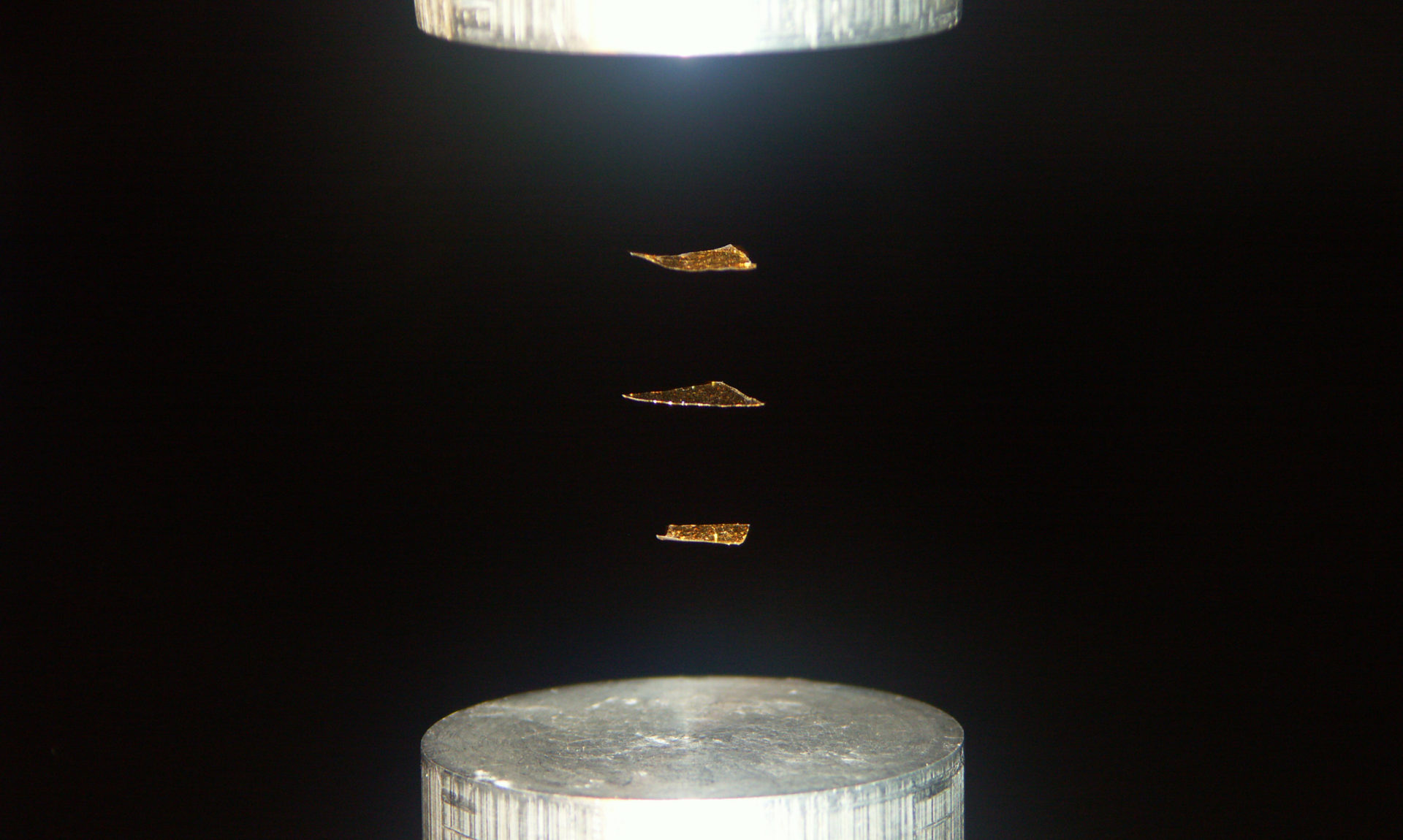Biorhythm: Music and the Body @ Science Gallery [ Dublin, Ireland ] July 2 -October 10, 2010
SEE THIS SOUND. Promises in Sound and Vision @ Lentos Kunstmuseum [ Linz, Austria ] August 28, 2009 – January 10, 2010
For this rendition of Sonolevitation, slivers of gold are acoustically suspended and spun in different directions at varying speeds. The spin reveals the rotary consequences of acoustic vibrations as well as the dynamics of frictionless motion (untainted by gravitational forces). A close-range microphone monitors the slivers’ modulation of the levitatory standing wave: the slightest disturbance or change in spin has highly audible repercussions.The slivers also interact with each other, modifying one another’s spin patterns.
Because optical radiation similarly exerts pressure on matter in a nodal fashion, precise analogies of frequency, wavelength and particle size can be made between acoustic and electromagnetic levitators. As such, sonic ‘force field tailoring’ serves as an ideal testing ground for colossal, long-wave electromagnetic levitators that will be a critical necessity for automated architectural engineering in microgravity. Acoustically levitated materials can also be efficaciously sculpted by sound fields, with specific variations in density that can turn free hanging micro-droplets of liquid into highly sensitive optical resonators suitable for lasing.
‘Space’ exploration is not only imperative for scientific and survivalist reasons, but also for purely aesthetic ends. Sonolevitation is the first in a series of projects in preparation for microgravitational, near-vacuous environments. The capacity to create artworks in large-scale vacuums (much larger than the ones that could ever be produced on Earth) permits the actuation of altogether unforeseen optical and acoustic processes.
About The Exhibit:
Artists today take an engagement with the sound of this world for granted. The former predominance of the visual has meanwhile been replaced by a multifaceted interplay of image and sound. Even though contemplative quiet still largely predominates in museums, sound, experimental composition, audiovisual media and pop culture have become central references for visual art in the 20th century. See This Sound documents this development from the perspective of visual art and refers to the respective contemporary discussions and promises.
In eight separate sections, See This Sound exhibits a number of important milestones and socio-historical reference points, in connection with which artists have worked with sound and composition and reflected on the medial relationship of image and sound.
Starting from the filmic sound visualizations of the 1920s – so-called Eye Music – it traces the topos of traversing genre boundaries in the 1960s and questions psychedelic trance machines and multimedia sound environments about their social-political potential. The illusion of a “natural” interplay of image and sound, for instance in Hollywood movies, is countered by works that disclose the discrepancies of this purported synthesis, all the way to the loss of sound and the power of speech. In addition, there is a special focus on the local production conditions of sounds (industrial cities and industrial sounds), and on sound as a medium of institutional critique. Astonishing promises have always been associated with the interplay of image and sound, with the crossover of visual art and music, in short: with “intermediality” – and sometimes still are up to the present, if we think of the idea of an “expanded visual culture” in the era of YouTube.
Artists:
Laurie Anderson, Martin Arnold, Atelier Hopfmann (Judith Hopf und Deborah Schamoni), John Baldessari, Gottfried Bechtold, Jordan Belson, Manon de Boer, George Brecht, Mary Ellen Bute, John Cage, Ira Cohen, Tony Conrad, Josef Dabernig, E.A.T. – Experiments in Art and Technology, Einstürzende Neubauten, Viking Eggeling, VALIE EXPORT, Oskar Fischinger, Andrea Fraser, William Furlong, Kerstin von Gabain, Jack Goldstein, Douglas Gordon, Dan Graham, Rodney Graham, Granular Synthesis, Brion Gysin, Carl Michael von Hausswolff, Gary Hill, Ludwig Hirschfeld-Mack, Heidrun Holzfeind, Derek Jarman, Jutta Koether, DIE KRUPPS, Peter Kubelka, Louise Lawler, Bernhard Leitner, LIA, Alvin Lucier, Len Lye, George Maciunas, Christian Marclay, Norman McLaren, Jonas Mekas, Michaela Melián, Robert Morris, Christian Philipp Müller, Wolfgang Müller, Max Neuhaus, Carsten Nicolai, Pauline Oliveros, Yoko Ono, Dennis Oppenheim, Nam June Paik, Nam June Paik & Jud Yalkut, Norbert Pfaffenbichler & Lotte Schreiber, Rudolf Pfenninger, Adrian Piper, Mathias Poledna, Hans Richter, Jozef Robakowski, David Rokeby, Constanze Ruhm / Ekkehard Ehlers, Walter Ruttmann, Peter Saville, Michael Snow, Imogen Stidworthy, Matt Stokes, Nina Stuhldreher, Atsuko Tanaka, TeZ, Throbbing Gristle, Tmema (Golan Levin und Zachary Lieberman), Ultra-red, Steina Vasulka, Ryszard Wasko, Peter Weibel, Hans Weigand, Herwig Weiser, James Whitney, La Monte Young, La Monte Young & Marian Zazeela sowie Audiobeiträge von Matthias Dusini und Thomas Edlinger.
The Exhibition Area Site.Sound.Industry was planed by Petra Erdmann and Christian Höller.
The comprehensive project See This Sound. Exhibition | Web Archive | Symposium is realized in close collaboration between Lentos Art Museum Linz, Linz 09 and the Ludwig Boltzmann Institute Media.Art.Research as an exhibition, research, and multimedia project.
